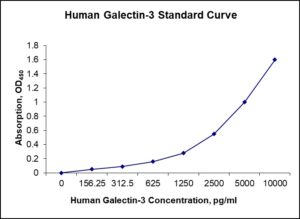Nori Human Galectin-3 ELISA Kit
$461.00 – $832.00
This ELISA kit is for quantification of galectin-3 in human. This is a quick ELISA assay that reduces time to 50% compared to the conventional method, and the entire assay only takes 3 hours. This assay employs the quantitative sandwich enzyme immunoassay technique and uses biotin-streptavidin chemistry to improve the performance of the assays. An antibody specific for galectin-3 has been pre-coated onto a microplate. Standards and samples are pipetted into the wells and any galectin-3 present is bound by the immobilized antibody. After washing away any unbound substances, a detection antibody specific for galectin-3 is added to the wells. Following wash to remove any unbound antibody reagent, a detection reagent is added. After intensive wash a substrate solution is added to the wells and color develops in proportion to the amount of galectin-3 bound in the initial step. The color development is stopped, and the intensity of the color is measured.
Alternative names for Galectin-3: Galectin 3, LGALS3
This product is for Laboratory Research Use Only not for diagnostic and therapeutic purposes or any other purposes.
- Description
- How Elisa Works
- Product Citation (0)
- Reviews (0)
Description
Nori Human Galectin-3 ELISA Kit Summary
Alternative names for Galectin-3: Galectin 3, LGALS3
| Assay Type | Solid Phase Sandwich ELISA |
| Format | 96-well Microplate or 96-Well Strip Microplate |
| Method of Detection | Colorimetric |
| Number of Targets Detected | 1 |
| Target Antigen Accession Number | P17931 |
| Assay Length | 3 hours |
| Quantitative/Semiquantitative | Quantitative |
| Sample Type | Plasma, Serum, Cell Culture, Urine, Cell/Tissue Lysates, Synovial Fluid, BAL, |
| Recommended Sample Dilution (Plasma/Serum) | No dilution for sample <ULOQ; sufficient dilution for samples >ULOQ |
| Sensitivity | 30 pg/mL |
| Detection Range | 0.156-10 ng/mL |
| Specificity | Natural and recombinant human galectin-3 |
| Cross-Reactivity | < 0.5% cross-reactivity observed with available related molecules, < 50% cross-species reactivity observed with species tested. |
| Interference | No significant interference observed with available related molecules |
| Storage/Stability | 4 ºC for up to 6 months |
| Usage | For Laboratory Research Use Only. Not for diagnostic or therapeutic use. |
| Additional Notes | The kit allows for use in multiple experiments. |
Standard Curve
Kit Components
1. Pre-coated 96-well Microplate
2. Biotinylated Detection Antibody
3. Streptavidin-HRP Conjugate
4. Lyophilized Standards
5. TMB One-Step Substrate
6. Stop Solution
7. 20 x PBS
8. Assay Buffer
Other Materials Required but not Provided:
1. Microplate Reader capable of measuring absorption at 450 nm
2. Log-log graph paper or computer and software for ELISA data analysis
3. Precision pipettes (1-1000 µl)
4. Multi-channel pipettes (300 µl)
5. Distilled or deionized water
Protocol Outline
1. Prepare all reagents, samples and standards as instructed in the datasheet.
2. Add 100 µl of Standard or samples to each well and incubate 1 h at RT.
3. Add 100 µl of Working Detection Antibody to each well and incubate 1 h at RT.
4. Add 100 µl of Working Streptavidin-HRP to each well and incubate 20 min at RT.
5. Add 100 µl of Substrate to each well and incubate 5-30 min at RT.
6. Add 50 µl of Stop Solution to each well and read at 450 nm immediately.
Background:
Galectin-3 is a protein that in humans is encoded by the LGALS3 gene.[1] Galectin-3 is a member of the lectin family, of which 14 mammalian galectins have been identified. Galectin-3 is approximately 30 kDa and, like all galectins, contains a carbohydrate-recognition-binding domain of about 130 amino acids that enable the specific binding of β-galactosides.[3] Galectin-3 (Gal-3) is also a member of the beta-galactoside-binding protein family that plays an important role in cell-cell adhesion, cell-matrix interactions, macrophage activation, angiogenesis, metastasis, apoptosis. Galectin-3 is expressed in the nucleus, cytoplasm, mitochondrion, cell surface, and extracellular space.[2] Galectin-3 has an affinity for beta-galactosides and exhibits antimicrobial activity against bacteria and fungi. Given galectin-3’s broad biological functionality, it has been demonstrated to be involved in cancer, inflammation and fibrosis, heart disease, and stroke.[3] Studies have also shown that the expression of galectin-3 is implicated in a variety of processes associated with heart failure, including myofibroblast proliferation, fibrogenesis, tissue repair, inflammation, and ventricular remodeling.[4] Galectin-3 associates with the primary cilium and modulates renal cyst growth in congenital polycystic kidney disease.[5] Chronic heart failure has been found to be indicated by a galectin-3 tests, the myocardial lining constantly undergoes necessary fibrosis, and the inhibition of galectin-3 interferes with myocardial fibrogenesis. A study concluded that drugs binding to galectin-3 will benefit those who have too much fibrosis on the heart, but it might potentially backfire for those who need heart restructuring.[6] Galectin-3 is upregulated in patients with idiopathic pulmonary fibrosis. The cells that receive galectin-3 stimulation (fibroblasts, epithelial cells, and myofibroblasts) upregulated the formation of fibrosis and collagen formation.[6] Galectin-3 is increasingly being used as a diagnostic marker for different cancers and has varying effects in different types of cancer.[7]
References
- Raz A, et al. (1991). Cancer Research. 51 (8): 2173–8.
- Liu FT, et al. (2002). Biochimica et Biophysica Acta. 1572 (2-3): 263–73.
- Sharma UC, et al. (2004). Circulation. 110 (19): 3121–8.
- Lin YH, et al. (2009). Clinica Chimica Acta; Int J Clinical Chem. 409 (1-2): 96–9.
- Chiu MG, et al. (2006). The American Journal of Pathology. 169 (6): 1925–38.
- Yu L, et al. (2013) Circulation: Heart Failure. 6 (1): 107–17.
- Idikio HA (2011). PLoS One. 6 (10): e26150.
Be the first to review “Nori Human Galectin-3 ELISA Kit”
You must be logged in to post a review.




























Reviews
There are no reviews yet.